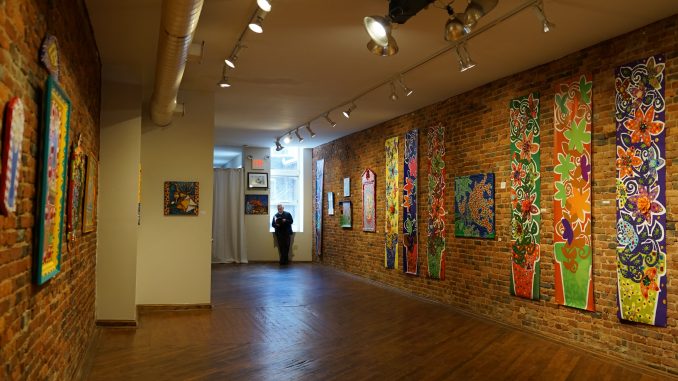
For Robin Halpren-Ruder, art is a way to present her attitude to the world.
“Hello! I’m here, recognize me,” she said. “I want you to see me.”
Her work consists of brightly colored paintings of flowers, fake food and landscapes, all usually outlined in white. She finds frames at flea markets and yard sales and has them filled with masonite — an engineered wood product — to create her pieces. She creates banners and adds rhinestones to some of her pieces.
Halpren-Ruder, who studied sculpture at Tyler School of Art in 1967 for two and a half years before she transferred to The School of the Art Institute of Chicago, and Bucks County-based artist Rae Chichilnitsky will have their work on display until April 2 at The Old City Jewish Arts Center. The theme of the exhibit this month, titled “The Color of Happiness,” celebrates the Jewish holiday Purim.
Purim is celebrated during the Hebrew calendar’s month of Adar, which is considered to be a month of happiness.

Zalman Wircberg — known as Rabbi Zash by his congregation — is the co-director of the Old City Jewish Arts Center. He said Purim is a joyous Jewish holiday that celebrates happiness and the survival of Jewish people being saved from extermination, based off the Book of Esther.
Purim this year occurred from sunset on March 11 to nightfall on March 12. Wircberg added that the holiday is very family oriented and is the “epitome of celebration.” Festivities during the holiday include dressing up in costumes, eating food and spending time with family.
Chichilnitsky’s work includes depictions of Queen Esther — the eponymous heroine of the Book of Esther — and several other religious scenes, figures and landscapes.
Halpren-Ruder said she wasn’t thinking about Purim when she was creating her art — just about making viewers happy.
She said that Henri Matisse, one of her artistic influences, created paintings that dance and sing, and that she tries to create that exuberance in the people that view her art.
Halpren-Ruder added that her work is influenced by graphic, pop and folk art.
“I paint what makes me feel good,” Halpren-Ruder said. “To bring a smile to someone’s face one day is just a really lovely thing to be able to do. So that’s the goal that I have, to take that moment and feel good and smile and then be able to deal with the rest of the world.”
“It was a perfect fit,” Wircberg said. “A perfect match for March for Purim. It’s very colorful, it’s very happy, it’s very bright. It just puts a smile on your face, and that’s kind of what this month is supposed to be doing.”
Wircberg added that the exhibit is adorned with quotes from ancient Jewish texts that relate to the theme. The goal was for people to walk through the exhibit and be enriched and educated about the different messages of joy and happiness in Judaism.
“Overall, we’re exploring the universal messages of Judaism through the universal language of arts,” Wircberg said. “Through the universal language of arts, we’re exploring and promoting universal messages of Judaism. What better way to do it than in an arts center?”
Moriah Thoman can be reached at moriah.thoman@temple.edu.


Be the first to comment